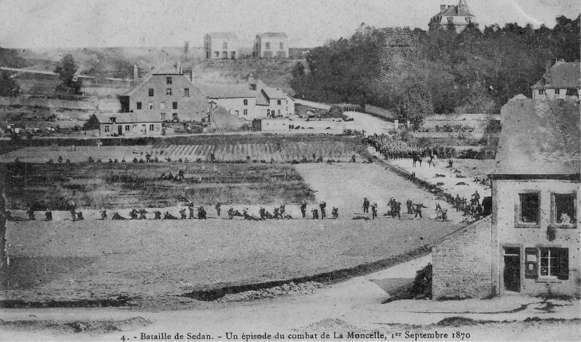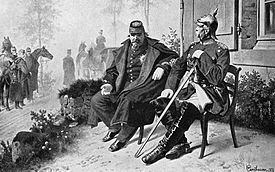200,000774 guns 130,000564 guns | Date 1 September 1870 | |
 | ||
2,320 dead5,980 wounded700 missingTotal9,000 casualties 3,000 dead14,000 wounded103,000 capturedTotal120,000 casualties Similar Franco‑Prussian War, Siege of Paris, Battle of Gravelotte, Battle of Königgrätz, Battle of Wörth | ||
1940 lego world war two second battle of sedan
The Battle of Sedan was fought during the Franco–Prussian War on 1 September 1870. It resulted in the capture of Emperor Napoleon III and large numbers of his troops and for all intents and purposes decided the war in favour of Prussia and its allies, though fighting continued under a new French government.
Contents
- 1940 lego world war two second battle of sedan
- Today in history french lose battle of sedan in franco prussian war 1870
- Background
- Battle
- Conclusion and aftermath
- References

The 120,000 strong French Army of Châlons, commanded by Marshal Patrice de MacMahon and accompanied by Napoleon III, was attempting to lift the Siege of Metz, only to be caught by the Prussian Meuse Army and defeated at the Battle of Beaumont. The Meuse Army and the Prussian Third Army, commanded by Field-Marshal Helmuth von Moltke and accompanied by Prussian King Wilhelm I and Prussian Chancellor Otto von Bismarck, cornered MacMahon's army at Sedan in a massive encirclement battle. Marshal MacMahon was wounded during the attacks and command passed to General Auguste-Alexandre Ducrot, until it was taken over by General Emmanuel Félix de Wimpffen.

Today in history french lose battle of sedan in franco prussian war 1870
Background

After its defeat at Gravelotte, Marshal Bazaine's Army of the Rhine retreated to Metz where it was besieged by over 150,000 Prussian troops of the First and Second Armies (Siege of Metz). Emperor Napoleon III, along with Marshal MacMahon, formed the new French Army of Châlons to march on to Metz to rescue Bazaine. With Napoleon III personally leading the army, and with Marshal MacMahon in attendance, they led the Army of Châlons in a left-flanking march northeast towards the Belgian border in an attempt to avoid the Prussians before striking south to link up with Bazaine.

The Prussians had repeatedly outmaneuvered the French in the string of victories through August 1870, and the march both depleted the French forces and left both flanks exposed. The Prussians, under the command of von Moltke, took advantage of this maneuver to catch the French in a pincer grip. Leaving the Prussian First and Second Armies besieging Metz, Moltke took the Prussian Third Army and the Army of the Meuse northward where they caught up with the French at Beaumont-en-Argonne on 30 August. After a hard-fought battle with the French losing 5,000 men and 40 cannons in a sharp fight, the French withdrew towards Sedan. Their intention was to rest the army, which had been involved in a long series of marches, resupply them with ammunition and then retreat, rather than giving battle in the town.
Having reformed in Sedan, the Army of Châlons deployed the First Corps to check the Prussian advance, but was immediately isolated by the converging Prussian armies. They could not retreat owing to the exhaustion of their troops, and they were short on ammunition. The French rear was protected by the Fortress of Sedan, and offered a defensive position at Calvaire d'Illy, which had both hills and woods to provide cover for any defense. Moltke divided his forces into three groups: one to detain the French where they were, another to race forward and catch them if they retreated, and a third (the smallest force) to hold the river bank. The French were unable to move and had to fight "where they stood". The Prussians thus encircled the French.
Battle
The battle opened with the Army of Châlons, with 202 infantry battalions, 80 cavalry squadrons and 564 guns, attacking the surrounding Prussian Third and Meuse Armies, which totaled 222 infantry battalions, 186 cavalry squadrons, and 774 guns.
Napoleon had ordered MacMahon to break out of the encirclement, and the only point where that seemed possible was La Moncelle, whose flank was protected by a fortified town. The Prussians also picked La Moncelle as one point where they would mount a breakthrough. Prince George of Saxony and the Prussian XI Corps was assigned to the task, and General Baron von der Tann were ordered to attack Bazeilles on the right flank.
This was the opening engagement, as the French First Corps had barricaded the streets, and enlisted the aid of the population. Von der Tann sent a brigade across pontoon bridges at 0400 hours, but encountered stiff resistance, holding only the southern end of the town. The combat drew new forces, as French brigades from the First, Fifth, and Twelfth Corps arrived. At 0800 the Prussian 8th Infantry Division arrived, and von der Tann decided it was time for a decisive attack. He had not been able to bring artillery to bear from long range, so he committed his last brigade to storm the town, supported by artillery from the other side of the Meuse. His artillery reached Bazeilles at 0900 hours.
The fighting continued to spread to the south of the town, and the 8th Infantry Division was sent to reinforce the Bavarians fighting at La Moncelle, where they had tried to break through the French defense. Fighting began in earnest at 0600, and the wounded MacMahon had appointed General Auguste Ducrot to command, who received the news at 0700. Ducrot ordered the retreat that Moltke had expected, but was overruled almost immediately by General de Wimpffen, who had been given a commission by the government to succeed MacMahon were he to become disabled. Wimpffen then threw his forces against the Saxons at La Moncelle. This led to a brief rally for the French, who drove back the artillery around La Moncelle and pressed the Bavarians and the Saxons. However, with the taking of Bazeilles, and the arrival of fresh waves of Prussian troops, the counter-attack began to collapse.
By 1100 hours, Prussian artillery took a toll on the French, while more Prussian troops arrived on the battlefield. Intense bombardment and Prussian attacks from the northwest and east, and Bavarian attacks from the southwest, drove the Army of Châlons into the Bois de la Garenne, where it was surrounded. The French cavalry, commanded by General Jean Auguste Margueritte, launched three desperate attacks on the nearby village of Floing where the Prussian XI Corps was concentrated. Margueritte was mortally wounded leading the very first charge, and the two additional charges led to nothing but heavy losses.
Conclusion and aftermath
By the end of the day, with no hope of breaking out, Napoleon III called off the attacks. The French lost over 17,000 men killed and wounded with 21,000 captured. The Prussians reported their losses at 2,320 killed, 5,980 wounded and 700 captured or missing.
By the next day, on 2 September, Napoleon III ordered the white flag to be run up and surrendered himself and the entire Army of Châlons to Moltke and the Prussian King. The capture of the French emperor left the Prussians without an opposing government willing to make a quick peace. Indeed, two days after news hit Paris of Emperor Napoleon's III capture, the French Second Empire collapsed in a bloodless revolution, leading to the creation of both the Paris Commune and a new provisional government which would carry on the war for five more months, working hand-in-glove in support of the Prussians in the crushing of the Commune.
However, the defeat at Sedan and the capture of Napoleon III and France's second line army, and with the first line French Army being shut up in Metz, sealed the doom of France and thus decided the outcome of the war in Prussia's favor. With the Second Empire overthrown, Napoleon III was permitted to leave Prussian custody for exile in England, while, within a fortnight, the Prussian Meuse Army and Third Army went on to besiege Paris.
In recognition of the role this battle played in German Unification, many Germans celebrated Sedantag (Day of Sedan) on each 2 September until 1919. The Kaiser himself refused to declare 2 September an official holiday; instead, it became an unofficial day of celebration.
